China’s navy is on track to be double the size of the United States’ by 2030, which puts U.S. interests at risk in the Asia Pacific and around the world, a U.S. military expert testified at a recent congressional hearing.
“The future size of the [People’s Liberation Army] Navy will be about 550 warships and submarines by 2030. That is twice the size of today’s U.S. Navy,” said Retired U.S. Navy Capt. James Fanell at a House Intelligence Committee hearing on Thursday.
“As such, it’s clear the U.S. Navy is at great risk. We simply are not adequately sized or outfitted to meet our national security commitments in the Indo-Asia Pacific, let alone around the globe,” said Fanell, former director of intelligence and information operations for the U.S. Navy’s Pacific Fleet.
Fanell said the Chinese navy, or PLAN, currently consists of about 400 warships — at least 330 surface ships and 66 submarines. Meanwhile, he said the U.S. Navy has 283 warships — 211 surface ships and 72 submarines.
While the U.S. Navy aims to grow to 355 ships by 2030, it is hotly debated whether it can be achieved.
Fanell and other experts who testified said the growth of China’s military — particularly its navy — is just one part of its plan to become the world’s superpower by 2050. That plan not only involves pushing the U.S. out of Asia, where it has allies and interests to defend, but expanding Chinese influence throughout the world.
“China, to date, has largely relied on its economic power to cultivate influence in its immediate neighborhood and beyond. But the PLA Navy is beginning to expand its reach to protect China’s growing interests,” said Patricia Kim, a fellow at the Council on Foreign Relations.
Already, China’s naval expansion has dramatically altered the strategic balance of power in the region and threatens to do so throughout the world, Fanell said.
“It’s not their words, but their actions and enormous expenditures that point to [China’s] expanding capability to use their maritime forces to coerce, intimidate and use force globally, as it is already doing regionally,” he said.
Richard D. Fisher Jr., of the International Assessment and Strategy Center, said despite China’s denials, it is building forces to project power beyond the Asia Pacific.
First, he said, China is assembling a “power-projection Navy” that, by 2030, may have the world’s first entirely nuclear-powered carrier battle group, which would enable aircraft carriers and their accompanying ships and forces to sail further and longer.
The Chinese military is also building their amphibious projection — or the ability to travel onto land by sea — and could have 12 large ships by the early 2030s and are reforming their marine force to about 100,000, he said.
In addition, he said, the PLA Air Force, or PLAAF, is building a projection air force, based on 100 to 200 large C-17 transport aircraft that can carry troops and heavy equipment, and lightweight airborne forces and medium-weight airborne projection forces “are anticipated,” he said.
And he said China is also using “debt trap diplomacy” to gain access for its military around the globe, where China will loan a large sum of money to a small country to help build a port but exact tough terms of repayment and, when the country cannot meet them, take control of the port for its own use, including as a potential military base in the future.
“China may be using debt pressure right now to force Djibouti to limit U.S. military access in that strategic base. It recently gained ownership of a new large port in Sri Lanka by debt default. Vanuatu, Pakistan, Thailand and others are vulnerable,” Fisher said.
He said China’s new “Belt and Road Initiative” is spreading “more and more loans and more and more opportunities for debt trap acquisitions.”
“From its One Belt One Road initiative to its unlawful maritime claims in the South China Sea, China is using its economic and military power to subvert international norms, undermine U.S. national security, threaten our friends and allies, and reshape the global balance of power,” said Chairman Devin Nunes (R-CA), who is planning a series of hearings on the topic.
Experts who testified recommended that the U.S. do more to confront China, work closely with allies, and strengthen its own military capabilities.
“Right now, our Navy can’t fight a war at sea,” Fanell said. “We’ve geared ourselves up for 30 years to fight a land war in Afghanistan and Iraq and Syria, but we’re not ready to fight a war in the middle of the Pacific Ocean.”
They also said the U.S. should do more to help Taiwan, which Fanell said China could attempt to take by force as early as the mid-2020s.
Fisher said if China does take Taiwan by force, it could turn Taiwan into a major nuclear and conventional military base, which would then trigger Chinese moves to isolate Japan and consolidate control over the South China Sea even more and project power into the Indian Ocean in order to isolate India.
“In conclusion, the United States has about a decade to prepare to deter a China well on its way to global power projection,” he said. “We have the ability to maintain military superiority if we commit to that goal. We can organize and lead our allies to higher levels of political coordination and economic security.”
“But the battle to hold off China starts at the Taiwan Strait, and we must ensure that freedom there survives and has a chance to form an eventual evolution away from China’s communist dictatorship,” he said.

COMMENTS
Please let us know if you're having issues with commenting.